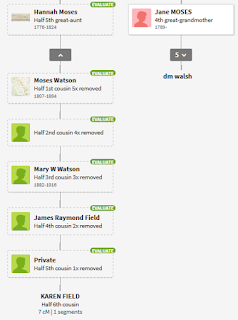I was going to write 'Ogre' but neither of our two Overlords were ogres. They were powerful enough, and their underlings too well schooled to argue with them, that they had no requirement to be nasty. Thanks to ThruLines I know I descend from one of them.
The First Overlord (West of the Pennines)
Joseph Moses (b. 1743) had two orphan daughters by his first wife (a cousin), namely, Mary and Hannah. Then his second wife brought him three lovely lasses, Elizabeth, Jenny and Margaret. The families of both wives were elided, and wherever Grandpa Moses went, some sons, daughters and grandchildren followed in light formation. (The above portrait is not Joseph, but his brother, Christopher, which nonetheless gives an idea about him.) The family lived at Huddlesceugh near Renwick on the west side of the Pennine Hills, somewhere in Cumberland. Joseph would have been an astute, respected, farmer and businessman who knew his own mind.
Joseph's Daughters
Jenny was particularly in the thrall of her father. She'd rebelled as a child and begun a romantic relationship with the penniless gardener, W. Dodd. They "eloped" in 1808, were forced to marry and in effect became tied to the family farm while Joseph still lived. Which he did: for a very long time.
Meanwhile, Margaret and Elizabeth had married well, to an Excise Officer and a medium landowner respectively. Mary and Hannah had married also, rather cautiously: Mary to a well connected local farmer, and Hannah (in 1797) to the widowed Mr Watson of Scalehouses, which will link, in a moment, to our genetic story.
Scalehouses backs right on to the Pennines with some sheep land rising to 2500 ft. The farm house is a decent size, white-painted, black-timbered, not overly tall and surrounded by its own land. The Watsons had long lived there but our Hannah made the place her own. She planted sycamore trees in the garden, which for all I know are still there.
The Moses men come out in force to witness these careful marriages. There's upwards of five witnesses. I don't know if this is a Northcountry trend, but the bevy of witnesses makes the point that the marriage is a significant family event. Notice this excerpt from a letter, which contains a rather throw-away comment about the daughters.
The Second Overlord (east of the Pennines)
Elizabeth, one of the wiser sisters, had a new brother-in-law, the powerful and influential Rev'd Christopher Bird, vicar of Chollerton, across the Pennines into Northumberland. He will be our second Overlord. When trouble strikes, it is to the Rev'd Mr Bird that the family will go.
Death of Joseph
Joseph Moses eventually died in 1833 at Morland Hall Farm, which he had presumably been renting, in the parish of Morland, near Penrith. He was 90.
Crossing into Bird territory
Jenny Dodd, her husband William, their younger children could all now pack their bags and escape. Frankly they had little choice. The Overlord had died and they were now at the mercy of the new Overlord, C. Bird.
So in 1833 the Dodds crossed the Pennines to Chollerton, where their eldest daughter was already living. Dodd found work as estate agent in Allendale (for Mr Bird). Their daughter Jane soon married the son of Mr Bird's bailiff, Johnny Gibson, although he was not her first choice, according to very well-informed petrified family gossip.
Daughter Jane Dodd (Gibson) is immortalised in our family as "Granny from Old Town". Despite being born back in 1814 in the wilds of Cumberland, she made an impression on a great-grandchild and so has "survived" into our epoch.
There are further twists and turns. My line, from Jenny Moses (Dodd) is not destined to remain east of the Pennines and the road ahead will be treacherous.
Hannah Moses's family at Scalehouses
Meanwhile, the Watsons remain at Scalehouses for generations and it is thanks to an old family letter from 1890 that we know of Hannah planting her sycamore trees. The letter is being sent, rather wistfully, to Australia. I think the writer knows contact will one day cease, despite his best efforts at logging every newly-arrived nephew and niece.
ThruLines
Ancestry ThruLines (which has already been added to my phone's spellchecker) is going to confirm something remarkable: Five times great-grandfather Joseph Moses, our first Overlord, is indisputably my forbear. One of the wiggly Watson lines which went out to Australia, match my DNA. Incredibly an even more remote cousin, in the States, holds the above portrait of Joseph's brother, C. Moses.
Without the ThruLines technology, which examines each generation carefully and rebuilds trees where details are missing, I'd never have worked out the connection to cousin Julie myself. This part of my tree is very distinctive. I have no other Cumberland ancestry, and neither, I suspect, has Julie. This lends a further weight of evidence to the suggested tree.
Whilst extremely impressive, DNA has already been able to take me back to an even more remote 'Most Recent Common Ancestor', this time from the 1600s... Stay tuned for more!







